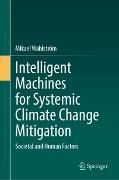Read more
This book argues that it is possible to reduce the use of fossil fuels and other natural resources substantially using present and near-future intelligent technologies, provided that human factors and societal perspectives are appropriately addressed. The first part of the book explains intelligent technologies in non-technical language. Topics covered include artificial intelligence, the Internet of Things, and sensing devices. Human and machine intelligence are compared in order to provide a realistic view of the division of labor between humans and machines. The second part of the book explains how intelligent machines could be used to reduce CO2 emissions through considering four technology application areas: road traffic, shipping, drone deliveries and production. The third and final part of the book summarizes and discusses the arguments made in the first and second part by considering the concept of intelligence and the environments in which intelligent machines may operate. Furthermore, public imagination is discussed, because – as argued in the second part of the book – societal change is necessary for enabling the positive technological transformations proposed in the book.
List of contents
Chapter 1. Introduction.- Chapter 2. Machine vs. human capabilities.- Chapter 3. Introduction to Part 2.- Chapter 4. Coordination or chaos through self-driving cars.- Chapter 5. Shipping of the future: the internet of intelligent ships.- Chapter 6. Drones and slowing down climate change: after war, hope.- Chapter 7. Connecting manufacturing industry to the circular economy.- Chapter 8. Summary for Part 2: division of labour and societal decisions.- Chapter 9. Believing is creating: intelligent machines for systemic transformation.
About the author
Mikael Wahlström is a senior scientist who works in the field of human factors at VTT Technical Research Centre of Finland. He has a Ph.D. in social psychology and the title of docent (adjunct professor) in social science at the University of Helsinki. His human factors research experience covers various work contexts, including nuclear power plant operations, maintenance work, the manufacturing industry, robotic surgery, and marine navigation. His research on human–technology interaction covers autonomous systems, virtual reality, robotics, and artificial intelligence. He has published in leading scientific journals on human–computer interaction and design studies.
Summary
This book argues that it is possible to reduce the use of fossil fuels and other natural resources substantially using present and near-future intelligent technologies, provided that human factors and societal perspectives are appropriately addressed. The first part of the book explains intelligent technologies in non-technical language. Topics covered include artificial intelligence, the Internet of Things, and sensing devices. Human and machine intelligence are compared in order to provide a realistic view of the division of labor between humans and machines. The second part of the book explains how intelligent machines could be used to reduce CO2 emissions through considering four technology application areas: road traffic, shipping, drone deliveries and production. The third and final part of the book summarizes and discusses the arguments made in the first and second part by considering the concept of intelligence and the environments in which intelligent machines may operate. Furthermore, public imagination is discussed, because – as argued in the second part of the book – societal change is necessary for enabling the positive technological transformations proposed in the book.

